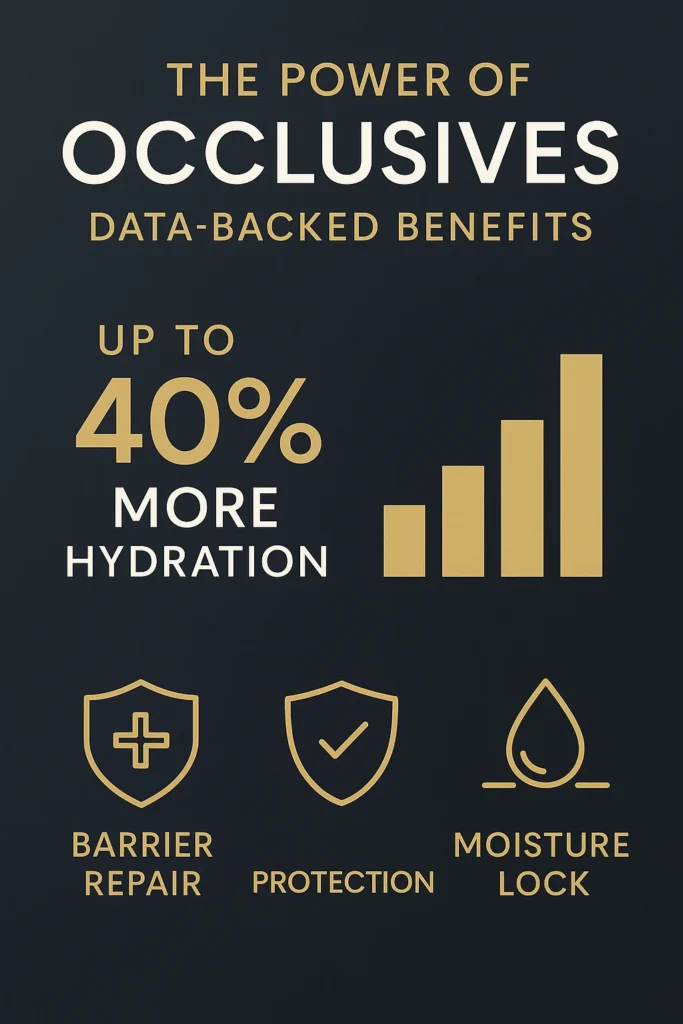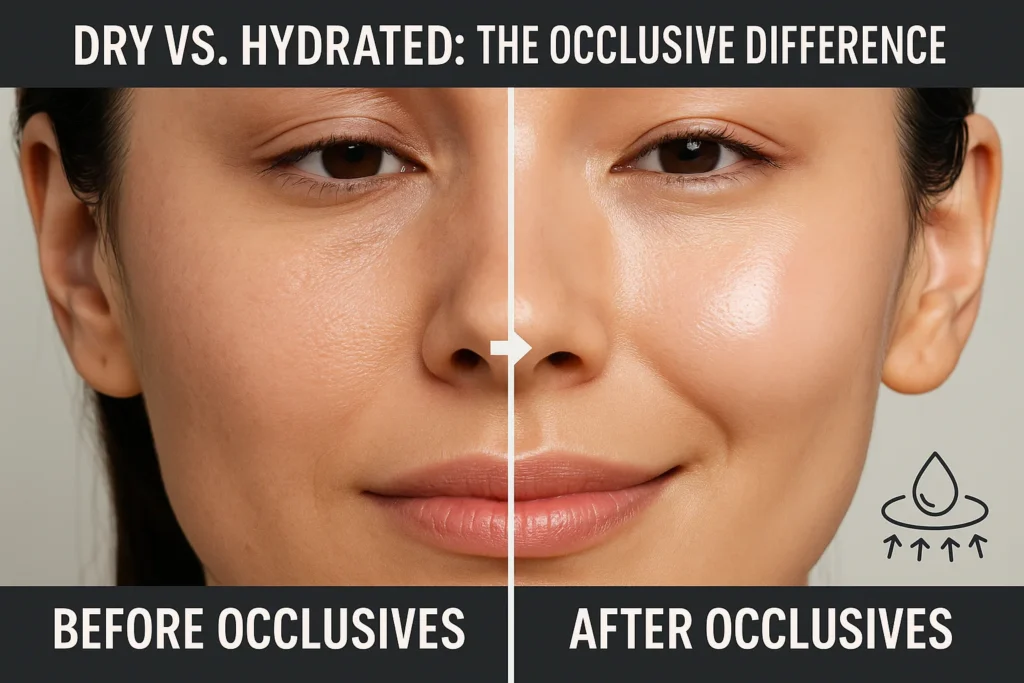Occlusives in skincare are special ingredients that form a protective layer on your skin. This layer helps stop moisture from leaving your skin. They are key for keeping skin hydrated and healthy.
In a Nutshell: Occlusives in Skincare
- You will understand what occlusives are and how they work.
- You will learn their main benefits for your skin.
- You will discover common occlusive ingredients and how to use them.
- You will know how to avoid common mistakes.
Estimated reading time: 6 minutes
Do you have dry skin? Or does your skin feel tight and flaky? Understanding occlusives in skincare can change your routine. These ingredients are like a protective shield for your skin. They help keep your skin soft and hydrated.
What Are Occlusives?
Occlusives are substances that create a barrier on your skin. Think of them like a thin, invisible film. This film traps moisture inside your skin. It stops water from evaporating into the air. This process is called transepidermal water loss, or TEWL.

By blocking TEWL, occlusives keep your skin from drying out. They do not add moisture directly. Instead, they seal in the moisture that is already there or that you have just applied. This makes them a vital last step in your moisturizing routine, especially at night. You can learn more about these ingredients from experts. Learn more about occlusive ingredients.
How Occlusives Work
Occlusives form a physical layer on your skin’s surface. This layer is often made of oils or waxes. It works by slowing down how fast water leaves your skin. Your skin’s outer layer, the stratum corneum, needs moisture to stay healthy. When this layer is weak, your skin can become dry, itchy, or easily irritated.
Common occlusive ingredients include petrolatum, mineral oil, and shea butter. They ensure that water and other moisturizers stay locked in your skin. This helps your skin heal and stay strong.
Benefits of Occlusives in Skincare
Using occlusives offers several important benefits for your skin.
1. Great for Moisture
Occlusives are excellent at keeping your skin hydrated. They stop water loss. This helps treat and prevent dry skin. Studies show that using occlusive moisturizers makes skin much more hydrated quickly. This is very helpful for skin that is dry or affected by cold weather.
2. Protects Your Skin
The barrier occlusives create also protects your skin. It shields your skin from dirt, allergens, and harsh weather. This can be wind or cold. This protection helps reduce irritation. It also keeps your skin’s structure strong.
3. Helps Skin Barrier Repair
Dermatologists often suggest occlusives for skin problems like eczema or psoriasis. They help repair a damaged skin barrier. By sealing the skin, they help it heal. This can also reduce skin sensitivity and redness.
4. Reduces Fine Lines
Occlusives can make your skin look plumper. They keep water in the skin. This can make fine lines and wrinkles less noticeable. While they do not directly fight aging, better hydration leads to smoother skin.
5. Works for Many Skin Types
Occlusives are great for dry and sensitive skin. Some can feel heavy or greasy. This might be a problem for oily or acne-prone skin. But newer products use lighter occlusives, like squalane. These work better for combination or oily skin. You can find more details on different types of occlusives. See more on occlusive skincare ingredients.
Popular Occlusive Ingredients
Here are some common occlusive ingredients you might find in skincare products:
These ingredients differ in how they feel and absorb. But all help keep moisture in your skin.
Modern Uses and Trends
Slugging Technique
“Slugging” is a popular skincare trend. It involves putting a thick layer of an occlusive, often petrolatum, on your face at night. This seals in all your other skincare products. It helps maximize hydration. Many people in the U.S. use this, especially in dry weather. It is also common for very dry skin.
Clinical Use
Dermatologists often suggest occlusives for very dry skin. They also recommend them for skin conditions like atopic dermatitis. The American Academy of Dermatology says petrolatum ointments work well. They are often less irritating than other moisturizers for dry skin.
New Products
Skincare companies are making occlusives feel less greasy. This makes them better for more skin types. Lighter occlusives like squalane are now in everyday moisturizers. This means more people can enjoy their benefits.
- Clean Skin: Always apply occlusives to clean, slightly damp skin. This traps more water.
- Layer Smart: Put occlusives last in your routine. They seal in serums and moisturizers.
- Start Small: Use a tiny amount first. You can always add more if needed.
- Night Use: Best for nighttime. They can feel heavy during the day.
- Watch Pores: If you have oily or acne-prone skin, use less. Avoid heavy ones on breakout areas.
Potential Side Effects

While helpful, occlusives have some things to consider:
- Greasy Feel: They can leave a heavy, shiny feel. This might not be comfortable for oily skin.
- Pore Clogging: Some occlusives, like petrolatum, can block pores. This might make acne worse for some people.
- Targeted Use: You might want to use them only on dry spots. This avoids making your whole face greasy.
- Allergies: Rarely, some people might be allergic to ingredients like lanolin or beeswax.
Occlusives vs. Other Moisturizers
Moisturizers work in different ways. They are often grouped into three types:
| Moisturizer Type | How It Works | Example Ingredients |
|---|---|---|
| Occlusives | Forms a barrier to block water loss | Petrolatum, mineral oil, squalane |
| Humectants | Pulls moisture to the skin | Hyaluronic acid, glycerin |
| Emollients | Softens and smooths skin | Fatty acids, ceramides, oils |
Many products mix these types. This helps hydrate, repair, and soften your skin. Occlusives are key for the final step to seal everything in. You can learn more about the basics of skincare. Discover the 5 basics of skin care.
My Experience with Occlusives
I often deal with dry skin, especially in winter. Using a thin layer of an occlusive as the last step in my nighttime routine has made a huge difference. My skin feels much softer and less tight by morning. It’s a simple trick that truly helps lock in moisture.
A quick checklist to help you use occlusives effectively.
Occlusives: Your Quick Checklist
- Clean Skin: Apply to clean, slightly damp skin. This helps trap more water.
- Last Step: Use occlusives as the very last step in your routine. They seal everything in.
- Small Amount: Start with a pea-sized amount. A little goes a long way.
- Night Use: Best for nighttime. They can feel heavy during the day.
- Watch for Clogging: If you have oily or acne-prone skin, use less. Avoid heavy ones on breakout areas.
Conclusion
Occlusives in skincare are vital for keeping your skin hydrated. They form a protective barrier that locks in moisture. This helps dry and sensitive skin. They also repair your skin barrier and protect it. By using them wisely, you can achieve healthier, softer skin.
Your Questions About Occlusives in Skincare Answered (Simply)
What is an occlusive in simple terms?
What is the difference between occlusives and humectants?
Is petrolatum a good occlusive?
Can occlusives cause acne?
When should I use occlusives in my skincare routine?
Are natural oils occlusive?
What is slugging in skincare?
- Clinically proven to reduce dark spots
- Safe, non-irritating botanical formula
- Visible results in just 2 weeks
- Deeply moisturizes all day long
- Boosts skin’s natural hydration barrier
- Lightweight, non-greasy texture
- Increases firmness and elasticity
- Minimizes fine lines & wrinkles
- Dermatologist-approved formula
- Targets old & new stretch marks
- Derm-tested for sensitive skin
- Results in as little as 4 weeks
- Soothes inflammation immediately
- Reduces flare-ups over time
- Fragrance-free & non-comedogenic
- Powered by collagen-boosting peptides
- Improves skin tone & texture
- For all skin types, even sensitive
- Improves scar texture & appearance
- Clinically tested on keloids
- Feel smoother, look renewed

